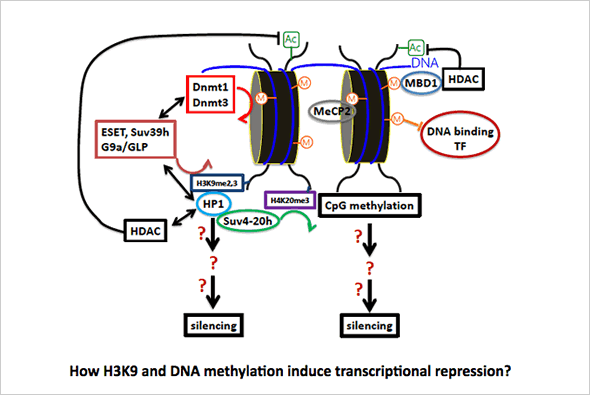Research Theme 1
Downstream signaling pathways for transcriptional repression mediated by H3K9 and DNA methylation
Since the completion of the human genome project in 2003, the complete genomes for various species have been determined. One of the important discoveries from those genome sequencing projects is that transposable elements (TEs) generally dominate genes in the complete genome.
For example, genes occupy less than 2% of the human genome, and TEs constitute >50% of this. Thus, evolution of existing species has been progressed with TEs. Transposition is, in most cases, either neutral or harmful for the hosts. Therefore, living organisms, including humans, have developed various defense mechanisms against TEs. Transcriptional silencing is the first defense mechanism against TEs integrated into the genome. DNA methylation plays important roles for transcriptional silencing of TEs. If genes crucial for de novo or maintenance DNA methylation are inactivated, TEs become highly derepressed and the derepressed active TEs become transposed. However, certain species such as yeast do not possess the DNA methylation system, but still TEs are repressed. Recent studies have described histone H3 lysine 9 (H3K9) methylation as another epigenetic mark that is commonly used for silencing TEs. In species ranging from yeast (fission yeast) to mammals, H3K9 methylation, especially di- and tri-methylation of H3K9 (H3K9me2 and 3) serves as a silencing mark. H3K9me2,3 recruits heterochromatin proteins HP1 by recognition of the chromo domain of HP1 to H3K9me2,3. This conserved epigenetic signaling cascade is thought to be crucial for gene silencing. However, the role of HP1 family of molecules in the induction of transcriptional silencing or the significance of the recruitment of HP1 for the silencing is not clearly known. The complete molecular mechanism underlying H3K9me-mediated gene silencing remains to be elucidated. We would like to address this biologically important question in our future research. Furthermore, we want to ask the same question to DNA methylation-mediated gene silencing because the repression mechanism of DNA methylation also remains poorly elucidated.




